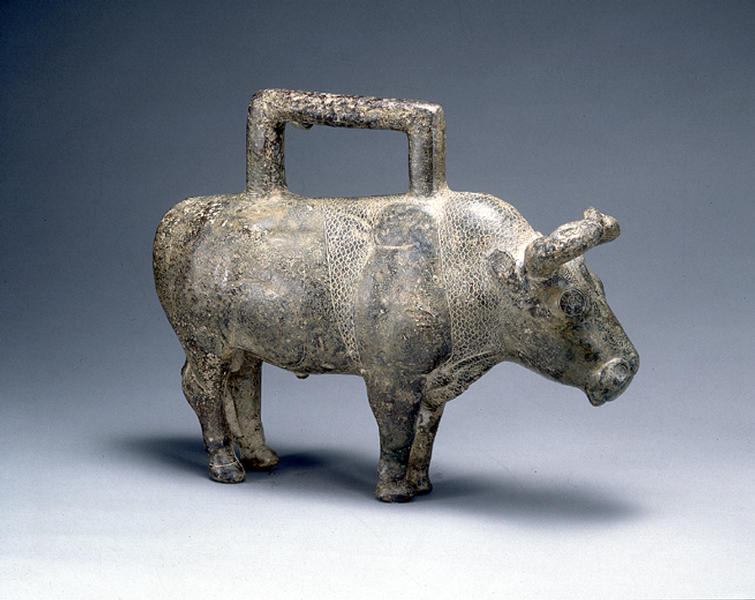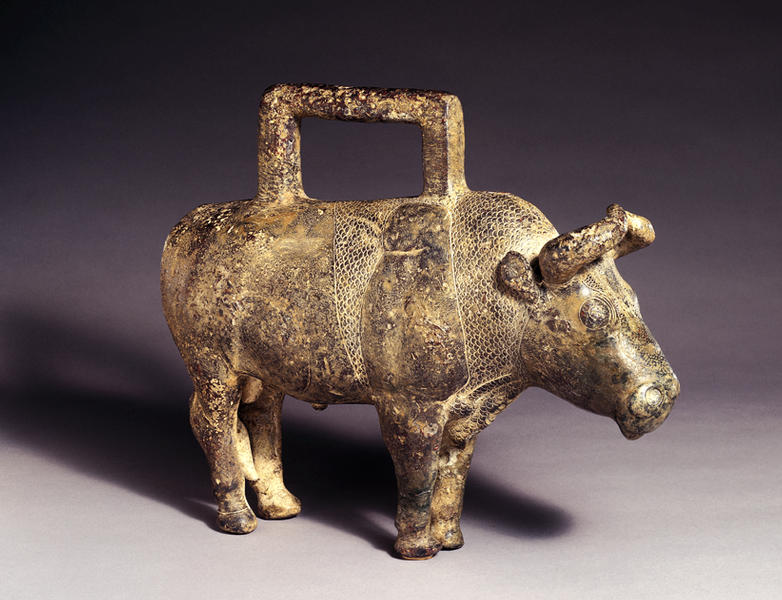牡牛像形分銅
- バクトリア地方
- 紀元前3千年紀後期-紀元前2千年紀初期
- 鉛
- H-26 W-32.4
頭をわずかに下げた非常に重量感のあるこの牡牛像は、胴体の筋肉組織の力強い造形と表面に描かれた文様が特異な結合をしているのが特徴的である。表面の文様は、肌のきめを表現するだけではなく、この動物の解剖学的構造をさらに詳細に線描するために付け加えられたものである。内湾した短い角、後方に折り曲げられた耳、丸くふくらんだ大きな目、鼻孔を示す丸みを帯びた刻み目、わずかに開いた口、何もかもこの像をユニークなものにしたてている。前脚と腹部と後脚は、それぞれの量感表現によって区分されている。のどぶくろの皮膚が前脚の間に垂れ下がり、性器が形作られ、先端が柔毛で覆われた尾が後脚の間に垂れ下がっている。前頭部、顎、胸の部分と、背中から腹部にかけての三角形部分には、うろこ状の文様が刻まれている。体毛を表現したものだろう。前頭部には盛り上がった逆三角形がある。また両端が梨形をした凸帯は、胸の筋肉と腱を表現したものと思われる。
古代の文化圏
紀元前三千年紀頃から南イランにエラム王国が興り、このアフガニスタン、東イランの鉱石原料や加工品のメソポタミアへと至る交易を支配しました。
エラムはメソポタミア.シュメールと密接な影響関係があり、またイラン高原、更に中央アジアに至る広範な地域がその文化圏の後背地であったと考えることが出来ます。
・Pierre Amiet/ The Period of Irano-Mesopotamian Contacts/ in 'Early Mesopotamia and Iran: Contact and Conflict 3500-1600 BC' ed.J.Curtis London 1993
婦人座像
鋸壁文円筒杯
獅子文様壺
農耕饗宴図杯
ラピスラズリロード
古代中央アジアで産出したラピス・ラズリがエジプトの神像に使われていた事は、当時すでにオリエント世界に広範な交易が存在した事を示しています。
エジプトではすでに紀元前4000年紀後半(3,500~3,000 B.C.頃)には彼の地では産しないラピスラズリを使った宝飾品が出現していますが、少なくとも紀元前三千年紀には、東はインダスの河谷地域からメソポタミアを中継し、西はエジプトに至る、いわゆるラピス・ラズリ=ロードと呼ばれる交易路が存在したと考えられています。
・Horst Klengel/ Handel und Haendler im alten Orient/ 1983 Leipzig
(古代オリエント商人の世界 江上波夫、五味亨訳 山川出版社 1983)
婦人座像
鋸壁文円筒杯
獅子文様壺
農耕饗宴図杯
分銅について
早くから交易の発達した中近東、中央アジア、インダス地域では当然その交易に必要な秤量システムも早くから発達し、その標準となる分銅が作られました。
中には東イランで制作されたと想像され石製容器に見られる国際様式の文様が刻まれた石製の分銅であると思われるものもあります。
これらはイラン、メソポタミアに広く分布し、ハンドバッグ型や円盤型、動物型などが見られます。材質も石のほかには鉛製のものがメソポタミアやバクトリア地方から出土しています。バクトリア地方の鉛製の分銅は円盤型で、その両面の中心に牛の図像をあらわしたものもあります。
・Oscar White Muscarella/ Inter Cultural Style " Weights"/ Bulletin of the Asia Institute 7 1993
・堀晄/ イランおよびアフガニスタン出土の分銅について/ 深井晋司博士追悼 シルクロード美術論集 吉川弘文館
彫刻か分銅か
この鉛製の牛は中央アジア、アフガニスタン北部、バクトリア地方のものと考えられていますが、背中に大変機能的な把手が付き、足は直立。咽の皮膚のたるみやごく自然な筋肉のつきかたなど極めて写実的な表現を見せています。
同地域に由来すると思われる円盤状の分銅にも見られますが、前半身から顔面中央にかけ特徴的な鱗状の体毛の意匠が施され、うつ向いた体勢をとっています。
重量の点では当時のバクトリア地方で使用されたと思われる単位とよく合致していると思われますが、頻繁に使用したならば磨耗するはずの把手が足よりも磨耗がない事と、形態から考えてすでに実用品の域を脱し、他の分銅でも指摘されるように権威を示すものとなっていたのではないかと思われます。あるいは一種の儀器であったのかもしれません。
このバクトリア地方は銀も豊富に産出し多くの銀器がつくられました。通常銀は鉛の鉱脈に含まれており、この銀を精錬する時に副産物としてできた鉛を分銅として適応したとも考えられます。
・堀晄/ イランおよびアフガニスタン出土の分銅について/ 深井晋司博士追悼 シルクロード美術論集 吉川弘文館 1987
この分銅の重さについて
当時のイラン-アフガニスタンではインダスで行われていたシステムと同じ重量単位が行われていました。
それによればインダスの単位は約0.86gであり、これに従えばこの牛像の重さ10,430gは約12,000(単位)となります。
・堀晄/ イランおよびアフガニスタン出土の分銅について/ 深井晋司博士追悼 シルクロード美術論集 吉川弘文館 1987
Catalogue Entry
This very massive figure of a bull, with its head slightly lowered, is characterized by the unusual combination of strong modeling of the musculature of the body with surface patterning, which was added not only for texture but also to further delineate the animal's anatomy. The bull has short horns that curve inward, folded-back ears, large circular bulging eyes, round indentations for nostrils, and a slightly open mouth. The forelegs, belly, and hindlegs are differentiated by modeling. The skin of the dewlap hangs between the front legs, the sexual organs are modeled, and the tail with its furry tip hangs between the hind legs. Areas of the forehead, jaw, and chest, and a triangle extending from the top of the back to the belly are incised with a scalloped pattern, most likely to indicate body fur. There is a raised pendant triangle on the forehead, and raised bands with piriform ends probably indicate the muscles and tendons of the chest. A circle is incised over a section of the belly and rump. Similar images of bulls are found on Bactrian silver cups with agricultural and chariot scenes (see cat. no. 17).1
The rectilinear handle on the back, combined with the material and the heaviness of the object, helps to identify it as a weight. However, while the feet are quite worn, indicating use, the handle from which the weight would have been suspended is not deformed in any way.2 Other objects from Bronze Age Bactria that have been identified as weights are large disks made of lead or stone, some with decorative inlays,3 and chlorite "pocket books" with carved figural and geometric decoration.4 The bull is one of the largest surviving ancient Near Eastern works made of lead. Its surface is in surprisingly good condition, perhaps indicating that it remained in a dry environment.5 Based on estimates of its weight and size, the bull appears to have been cast over a core.
JA
1. See Amiet 1988b, p. 136, fig. 9, p. 163, fig. 6.
2. This observation was made by Richard Stone, conservator in the Department of Objects Conservation at The Metropolitan Museum of Art.
3. See Pottier 1984, pp. 43-44.
4. See Muscarella 1993, pp. 143-54.
5. For the climate of the Bactria-Margiana region see Hiebert 1994b, pp. 6 ff.
解説(古代バクトリア遺宝展)
前三千年紀後期―前二千年紀初期
鉛
高26.0 cm 幅32.4 cm
前半身の毛並み表現、俯き加減の体勢、尻尾の垂れ具合など作品6に見られるものと極めて類似した形象をもち、筋肉の的確な成型と喉の弛みなどに見られるように大変現実味のある牡牛を鉛で作り出している。背中に矩形の把手が付けられているが、元来分銅として作られたことが想像される。これと同時代と思われる鉛の分銅が知られているが、それは円盤形で中央に同形の牡牛を線刻で表し、その上に矩形の把手の穴があけられ、周囲には透彫で鋸壁文を配している。これに対しこの牡牛像は優れて、彫刻的である。
古くからメソポタミアと資源交易が行われてきたイラン、バクトリア地域では、メソポタミアの60進法秤量システムよりも比較的早く10進法秤量システムが発達した。その単位は約0.86グラムにあたるが、この牡牛の10,430グラムに当てはめた場合、およそ12,000単位になる。インダス川流域やバクトリアではこの半分の重量の分銅が知られている。
Catalogue Entry(Bac#008)
Late 3rd‐early 2nd millennium B.C.
Lead
H. 26.0 cm, W. 32.4 cm
The depiction of this bull, with its hair expression on the forequarters, bowed down head, and hanging tail, is very close to these elements seen on the bulls in cat. No. 6. This bull has been extremely realistically depicted in lead, from its appropriately formed musculature to its relaxed throat. A rectangular handle is attached to his back, and we can imagine that it was originally used as a weight. There is another lead weight thought to be from the same period as this bull, but this weight is a round disk shape with a line incised image of the same form of ox on its center. Holes are cut above that bull for a rectangular handle, and surrounding it are crenellated patterns drawn in openwork carving. Conversely, here we have a superbly sculpted 3D form.
In the Iran/Bactrian areas which had long carried out basic materials trade with Mesopotamia, they used the decimal system which was simpler than the sexagesimal system used in Mesopotamia. The unit for this Bactrian weight system was approximately, 0.86 g and since this bull weighs 10,430 grams, then we can see that it was a 12,000 unit weight. There are weights of half this weight known from the Indus Valley region and Bactria.

